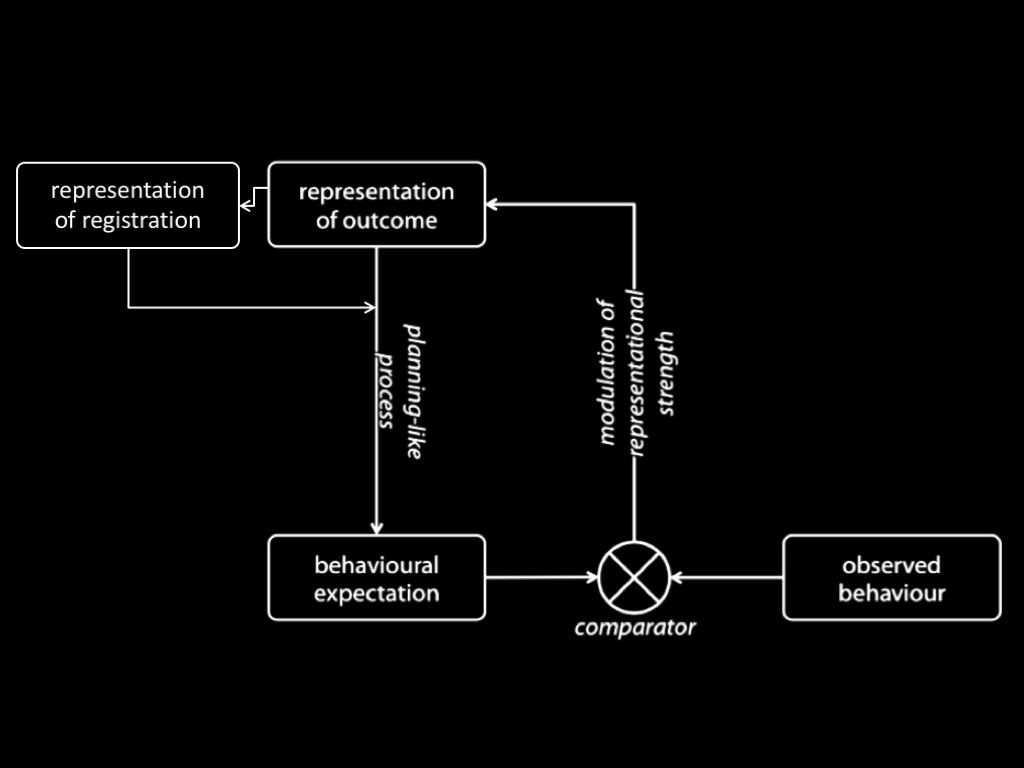Background
Mindreading is the process of identifying a mental state as a mental state that some particular individual, another or yourself, has.
To say someone has a theory of mind is another way of saying that she is capable of mindreading.
Butterfill & Apperly (2013) constructed a minimal theory of mind.
This theory describes a model of minds and actions which, if it were implemented,
would enable you to track others’ false beliefs. At least within limits.
This minimal model has a signature limit: it does not enable you to track false
beliefs which essentially involve a mistake about numerical identity. Such as Lois Lane’s
false belief that Superman and Clark Kent are distinct people (Jerry & Joe, 1939).
Signature limits generate predictions.
Automatic belief-tracking in adults, and
belief-tracking in infants, are both subject to signature limits
associated with minimal theory of mind.
The Kovács Effect
Kovács, Téglás, & Endress (2010) established that another’s irrelevant belief
can influence how quickly you can detect the presence of an object.
Despite some initial doubts (Phillips et al., 2015),
this finding has been widely replicated by several labs
(including Wel, Sebanz, & Knoblich, 2014; Edwards & Low, 2017; El Kaddouri, Bardi, De Bremaeker, Brass, & Wiersema, 2020).
Question
Why do others’ false beliefs ever have an effect on your own actions?
Motor Mindreading Conjecture

Predictions of the Conjecture
-
In motor mindreading only, goal-tracking will manifest sensitivity to agents’ beliefs.
-
In motor mindreading only, physically constraining protagonists or participants will impair belief tracking.
This talk concerns the second prediction only.
Findings So Far
Low, Edwards, & Butterfill (2020) support the prediction: physically constraining a protagonist did impair belief tracking.
Six (2022, p. Experiment 2) did not support the prediction: physically constraining participants
did not impair their belief tracking.
And the results from a study in preparation that builds on Zani, Butterfill, & Low (2020)’s balance paradigm
found only suggestive evidence for the prediction.
Bargh, J. A. (1992). The Ecology of Automaticity: Toward Establishing the Conditions Needed to Produce Automatic Processing Effects.
The American Journal of Psychology,
105(2), 181–199.
https://doi.org/10.2307/1423027Butterfill, S. A., & Apperly, I. A. (2013). How to construct a minimal theory of mind.
Mind and Language,
28(5), 606–637.
https://doi.org/10.1111/mila.12036Carruthers, P. (2015a). Mindreading in adults: Evaluating two-systems views.
Synthese,
forthcoming, 1–16.
https://doi.org/10.1007/s11229-015-0792-3Carruthers, P. (2015b). Two systems for mindreading?
Review of Philosophy and Psychology,
7(1), 141–162.
https://doi.org/10.1007/s13164-015-0259-yEdwards, K., & Low, J. (2017). Reaction time profiles of adults’ action prediction reveal two mindreading systems.
Cognition,
160, 1–16.
https://doi.org/10.1016/j.cognition.2016.12.004Edwards, K., & Low, J. (2019). Level 2 perspective-taking distinguishes automatic and non-automatic belief-tracking.
Cognition,
193, 104017.
https://doi.org/10.1016/j.cognition.2019.104017El Kaddouri, R., Bardi, L., De Bremaeker, D., Brass, M., & Wiersema, J. R. (2020). Measuring spontaneous mentalizing with a ball detection task: Putting the attention-check hypothesis by Phillips and colleagues (2015) to the test.
Psychological Research,
84(x), 1749–1757.
https://doi.org/10.1007/s00426-019-01181-7Jerry, S., & Joe, S. (1939). Superman.
Superman., (1).
Kampis, D., & Kovács, Á. M. (2022). Seeing the World From Others’ Perspective: 14-Month-Olds Show Altercentric Modulation Effects by Others’ Beliefs.
Open Mind,
5, 189–207.
https://doi.org/10.1162/opmi_a_00050Kovács, Á. M., Téglás, E., & Endress, A. D. (2010). The social sense: Susceptibility to others’ beliefs in human infants and adults.
Science,
330(6012), 1830–1834.
https://doi.org/10.1126/science.1190792Kulke, L., von Duhn, B., Schneider, D., & Rakoczy, H. (2018). Is Implicit Theory of Mind a Real and Robust Phenomenon? Results From a Systematic Replication Study.
Psychological Science, 0956797617747090.
https://doi.org/10.1177/0956797617747090Low, J., Drummond, W., Walmsley, A., & Wang, B. (2014). Representing how rabbits quack and competitors act: Limits on preschoolers’ efficient ability to track perspective.
Child Development,
forthcoming.
Low, J., Edwards, K., & Butterfill, S. A. (2020). Visibly constraining an agent modulates observers’ automatic false-belief tracking.
Scientific Reports,
10(1), 11311.
https://doi.org/10.1038/s41598-020-68240-7Low, J., & Watts, J. (2013). Attributing false-beliefs about object identity is a signature blindspot in humans’ efficient mindreading system.
Psychological Science,
24(3), 305–311.
Moors, A. (2014). Examining the mapping problem in dual process models. In
Dual process theories of the social mind (pp. 20–34). Guilford.
Moors, A., & De Houwer, J. (2006). Automaticity: A Theoretical and Conceptual Analysis.
Psychological Bulletin,
132(2), 297–326.
https://doi.org/10.1037/0033-2909.132.2.297Mozuraitis, M., Chambers, C. G., & Daneman, M. (2015). Privileged versus shared knowledge about object identity in real-time referential processing.
Cognition,
142, 148–165.
https://doi.org/10.1016/j.cognition.2015.05.001Oktay-Gür, N., Schulz, A., & Rakoczy, H. (2018). Children exhibit different performance patterns in explicit and implicit theory of mind tasks.
Cognition,
173, 60–74.
https://doi.org/10.1016/j.cognition.2018.01.001Phillips, J., Ong, D. C., Surtees, A. D. R., Xin, Y., Williams, S., Saxe, R., & Frank, M. C. (2015). A Second Look at Automatic Theory of Mind: Reconsidering Kovács, Téglás, and Endress (2010).
Psychological Science,
26(9), 1353–1367.
https://doi.org/10.1177/0956797614558717Premack, D., & Woodruff, G. (1978). Does the chimpanzee have a theory of mind?
Behavioral and Brain Sciences,
1(04), 515–526.
https://doi.org/10.1017/S0140525X00076512Scott, R. M., Richman, J. C., & Baillargeon, R. (2015). Infants understand deceptive intentions to implant false beliefs about identity: New evidence for early mentalistic reasoning.
Cognitive Psychology,
82, 32–56.
https://doi.org/10.1016/j.cogpsych.2015.08.003Sinigaglia, C., Quarona, D., Riva, G., & Butterfill, S. A. (2021). Seeing ain‘t believing: How we read other minds.
In Preparation,
x(x).
Six, P. (2022).
Observing Action in Uncertainty: The Role of Belief-tracking in Action Observation (Thesis). Te Herenga Waka-Victoria University of Wellington.
https://doi.org/10.26686/wgtn.19669581Wang, B., Hadi, N. S. A., & Low, J. (2015). Limits on efficient human mindreading: Convergence across chinese adults and semai children.
British Journal of Psychology,
106(4), 724–740.
https://doi.org/10.1111/bjop.12121Wel, R. P. R. D. van der, Sebanz, N., & Knoblich, G. (2014). Do people automatically track others’ beliefs? Evidence from a continuous measure.
Cognition,
130(1), 128–133.
https://doi.org/10.1016/j.cognition.2013.10.004Zani, G., Butterfill, S. A., & Low, J. (2020). Mindreading in the balance: Adults’ mediolateral leaning and anticipatory looking foretell others’ action preparation in a false-belief interactive task.
Royal Society Open Science,
7(1), 191167.
https://doi.org/10.1098/rsos.191167
